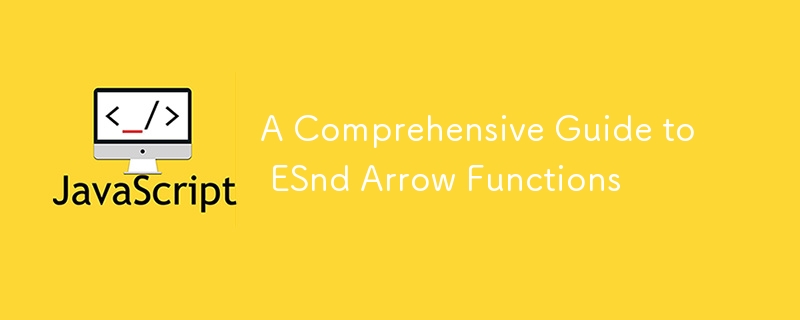ESnd 箭头函数综合指南

ES6简介
ECMAScript 2015,也称为 ES6 (ECMAScript 6),是对 JavaScript 的重大更新,引入了新的语法和功能,使编码更高效、更易于管理。 JavaScript 是用于 Web 开发的最流行的编程语言之一,ES6 的改进大大增强了其功能。
本指南将涵盖 ES6 中引入的重要功能,特别关注 箭头函数,一种强大的新函数编写方式。
ES6 的主要特性
1. let 和 const
ES6引入了两种新的变量声明方式:let和const。
-
let:声明块作用域变量,这意味着该变量仅在声明它的块内可用。
let x = 10; if (true) { let x = 2; console.log(x); // 2 (inside block) } console.log(x); // 10 (outside block) -
const:声明一个不能重新赋值的常量变量。然而,这并不会使变量不可变——使用 const 声明的对象仍然可以更改其属性。
const y = 10; y = 5; // Error: Assignment to constant variable. const person = { name: "John", age: 30 }; person.age = 31; // This is allowed.
2. 箭头函数
ES6 最受关注的功能之一是箭头函数。它为编写函数提供了更短、更简洁的语法。
#### 语法比较:
传统函数(ES5):
var add = function(x, y) {
return x y;
};
箭头函数 (ES6):
const add = (x, y) => x y;
箭头函数的不同之处如下:
- 更短的语法:不需要写function关键字,如果函数只有一条语句,可以省略大括号{}。
- 隐式返回:如果函数只包含一个表达式,则自动返回该表达式的结果。
- 没有 this 绑定:箭头函数没有自己的 this,使得它们不适合对象方法。
单线箭头函数示例:
const multiply = (a, b) => a * b; console.log(multiply(4, 5)); // 20
箭头函数也可以不带参数使用:
const greet = () => "Hello, World!"; console.log(greet()); // "Hello, World!"
对于多行函数,需要大括号{},并且返回语句必须显式:
const sum = (a, b) => {
let result = a b;
return result;
};
箭头函数和 this
一个重要的区别是箭头函数中的行为方式。与传统函数不同,箭头函数不绑定自己的 this — 它们从周围的上下文继承 this。
const person = {
name: "John",
sayName: function() {
setTimeout(() => {
console.log(this.name);
}, 1000);
}
};
person.sayName(); // "John"
在上面的示例中,setTimeout 中的箭头函数从 sayName 方法继承了 this,它正确引用了 person 对象。
3. 解构赋值
解构允许我们从数组或对象中提取值,并以更简洁的方式将它们分配给变量。
对象解构:
const person = { name: "John", age: 30 };
const { name, age } = person;
console.log(name); // "John"
console.log(age); // 30
数组解构:
const fruits = ["Apple", "Banana", "Orange"]; const [first, second] = fruits; console.log(first); // "Apple" console.log(second); // "Banana"
4. 展开和休息运算符 (...)
... 运算符可用于将数组展开为单个元素或将多个元素收集到一个数组中。
-
Spread:将数组扩展为单个元素。
const numbers = [1, 2, 3]; const newNumbers = [...numbers, 4, 5]; console.log(newNumbers); // [1, 2, 3, 4, 5]
-
Rest:将多个参数收集到一个数组中。
function sum(...args) { return args.reduce((acc, curr) => acc curr); } console.log(sum(1, 2, 3, 4)); // 10
5. 承诺
Promises 用于处理 JavaScript 中的异步操作。 Promise 代表了一个可能现在、将来或永远不可用的值。
例子:
const myPromise = new Promise((resolve, reject) => {
setTimeout(() => {
resolve("Success!");
}, 1000);
});
myPromise.then(result => {
console.log(result); // "Success!" after 1 second
});
在此示例中,promise 在 1 秒后解析,then() 方法处理解析后的值。
6. 默认参数
在ES6中,可以为函数参数设置默认值。当未提供或未定义参数时,这很有用。
例子:
function greet(name = "Guest") {
return `Hello, ${name}!`;
}
console.log(greet()); // "Hello, Guest!"
console.log(greet("John")); // "Hello, John!"
7. 字符串方法(包括()、startsWith()、endsWith())
新方法已添加到字符串中以使常见任务变得更容易:
-
includes():检查字符串是否包含指定值。
let str = "Hello world!"; console.log(str.includes("world")); // true -
startsWith():检查字符串是否以指定值开头。
console.log(str.startsWith("Hello")); // true -
endsWith():检查字符串是否以指定值结尾。
console.log(str.endsWith("!")); // true
8. 数组方法 (find(), findIndex(), from())
ES6 引入了处理数组的新方法:
-
find():返回第一个满足条件的元素。
const numbers = [5, 12, 8, 130, 44]; const found = numbers.find(num => num > 10); console.log(found); // 12
-
findIndex():返回第一个满足条件的元素的索引。
const index = numbers.findIndex(num => num > 10); console.log(index); // 1 (position of 12 in the array)
9. 课程
ES6 向 JavaScript 引入了类,它们是 JavaScript 现有的基于原型的继承的语法糖。类允许更清晰、更易于理解的面向对象编程。
例子:
class Car {
constructor(brand, year) {
this.brand = brand;
this.year = year;
}
displayInfo() {
return `${this.brand} from ${this.year}`;
}
}
const myCar = new Car("Toyota", 2020);
console.log(myCar.displayInfo()); // "Toyota from 2020"
结论
ES6 改变了 JavaScript,使其更高效、更易于使用。 箭头函数的引入简化了函数语法,而解构、promises、classes和扩展运算符等新功能 允许开发人员编写更清晰、更具表现力的代码。无论您是初学者还是高级开发人员,了解这些 ES6 功能对于编写现代 JavaScript 至关重要。
通过掌握这些概念,您将能够更好地应对现实世界的编码挑战并构建高效、可扩展的 Web 应用程序。
跟进 GitHub 上的 Arrow Functions 项目
参考
- https://www.w3schools.com/js/js_es6.asp
- https://towardsdatascience.com/javascript-es6-iterables-and-iterators-de18b54f4d4
- https://developer.mozilla.org/en-US/docs/Web/JavaScript/Reference/Functions/rest_parameters
- https://developer.mozilla.org/en-US/docs/Web/JavaScript/Reference/Functions/Default_parameters
- https://developer.mozilla.org/en-US/docs/Web/JavaScript/Reference/Functions/Arrow_functions
- https://developer.mozilla.org/en-US/docs/Web/JavaScript/Reference/Statements
-
 为什么不使用CSS`content'属性显示图像?在Firefox extemers属性为某些图像很大,&& && && &&华倍华倍[华氏华倍华氏度]很少见,却是某些浏览属性很少,尤其是特定于Firefox的某些浏览器未能在使用内容属性引用时未能显示图像的情况。这可以在提供的CSS类中看到:。googlepic { 内容:url(&#...编程 发布于2025-04-02
为什么不使用CSS`content'属性显示图像?在Firefox extemers属性为某些图像很大,&& && && &&华倍华倍[华氏华倍华氏度]很少见,却是某些浏览属性很少,尤其是特定于Firefox的某些浏览器未能在使用内容属性引用时未能显示图像的情况。这可以在提供的CSS类中看到:。googlepic { 内容:url(&#...编程 发布于2025-04-02 -
 为什么不````''{margin:0; }`始终删除CSS中的最高边距?在CSS 问题:不正确的代码: 全球范围将所有余量重置为零,如提供的代码所建议的,可能会导致意外的副作用。解决特定的保证金问题是更建议的。 例如,在提供的示例中,将以下代码添加到CSS中,将解决余量问题: body H1 { 保证金顶:-40px; } 此方法更精确,避免了由全局保证金重置引...编程 发布于2025-04-02
为什么不````''{margin:0; }`始终删除CSS中的最高边距?在CSS 问题:不正确的代码: 全球范围将所有余量重置为零,如提供的代码所建议的,可能会导致意外的副作用。解决特定的保证金问题是更建议的。 例如,在提供的示例中,将以下代码添加到CSS中,将解决余量问题: body H1 { 保证金顶:-40px; } 此方法更精确,避免了由全局保证金重置引...编程 发布于2025-04-02 -
 Java是否允许多种返回类型:仔细研究通用方法?在Java中的多个返回类型:一种误解类型:在Java编程中揭示,在Java编程中,Peculiar方法签名可能会出现,可能会出现,使开发人员陷入困境,使开发人员陷入困境。 getResult(string s); ,其中foo是自定义类。该方法声明似乎拥有两种返回类型:列表和E。但这确实是如此吗...编程 发布于2025-04-02
Java是否允许多种返回类型:仔细研究通用方法?在Java中的多个返回类型:一种误解类型:在Java编程中揭示,在Java编程中,Peculiar方法签名可能会出现,可能会出现,使开发人员陷入困境,使开发人员陷入困境。 getResult(string s); ,其中foo是自定义类。该方法声明似乎拥有两种返回类型:列表和E。但这确实是如此吗...编程 发布于2025-04-02 -
 如何将来自三个MySQL表的数据组合到新表中?mysql:从三个表和列的新表创建新表 答案:为了实现这一目标,您可以利用一个3-way Join。 选择p。*,d.content作为年龄 来自人为p的人 加入d.person_id = p.id上的d的详细信息 加入T.Id = d.detail_id的分类法 其中t.taxonomy =...编程 发布于2025-04-02
如何将来自三个MySQL表的数据组合到新表中?mysql:从三个表和列的新表创建新表 答案:为了实现这一目标,您可以利用一个3-way Join。 选择p。*,d.content作为年龄 来自人为p的人 加入d.person_id = p.id上的d的详细信息 加入T.Id = d.detail_id的分类法 其中t.taxonomy =...编程 发布于2025-04-02 -
 如何将多种用户类型(学生,老师和管理员)重定向到Firebase应用中的各自活动?Red: How to Redirect Multiple User Types to Respective ActivitiesUnderstanding the ProblemIn a Firebase-based voting app with three distinct user type...编程 发布于2025-04-02
如何将多种用户类型(学生,老师和管理员)重定向到Firebase应用中的各自活动?Red: How to Redirect Multiple User Types to Respective ActivitiesUnderstanding the ProblemIn a Firebase-based voting app with three distinct user type...编程 发布于2025-04-02 -
 如何使用Java.net.urlConnection和Multipart/form-data编码使用其他参数上传文件?使用http request 上传文件上传到http server,同时也提交其他参数,java.net.net.urlconnection and Multipart/form-data Encoding是普遍的。 Here's a breakdown of the process:Mu...编程 发布于2025-04-02
如何使用Java.net.urlConnection和Multipart/form-data编码使用其他参数上传文件?使用http request 上传文件上传到http server,同时也提交其他参数,java.net.net.urlconnection and Multipart/form-data Encoding是普遍的。 Here's a breakdown of the process:Mu...编程 发布于2025-04-02 -
 哪种方法更有效地用于点 - 填点检测:射线跟踪或matplotlib \的路径contains_points?在Python Matplotlib's path.contains_points FunctionMatplotlib's path.contains_points function employs a path object to represent the polygon.它...编程 发布于2025-04-02
哪种方法更有效地用于点 - 填点检测:射线跟踪或matplotlib \的路径contains_points?在Python Matplotlib's path.contains_points FunctionMatplotlib's path.contains_points function employs a path object to represent the polygon.它...编程 发布于2025-04-02 -
 如何检查对象是否具有Python中的特定属性?方法来确定对象属性存在寻求一种方法来验证对象中特定属性的存在。考虑以下示例,其中尝试访问不确定属性会引起错误: >>> a = someClass() >>> A.property Trackback(最近的最新电话): 文件“ ”,第1行, AttributeError: SomeClass...编程 发布于2025-04-02
如何检查对象是否具有Python中的特定属性?方法来确定对象属性存在寻求一种方法来验证对象中特定属性的存在。考虑以下示例,其中尝试访问不确定属性会引起错误: >>> a = someClass() >>> A.property Trackback(最近的最新电话): 文件“ ”,第1行, AttributeError: SomeClass...编程 发布于2025-04-02 -
 在细胞编辑后,如何维护自定义的JTable细胞渲染?在JTable中维护jtable单元格渲染后,在JTable中,在JTable中实现自定义单元格渲染和编辑功能可以增强用户体验。但是,至关重要的是要确保即使在编辑操作后也保留所需的格式。在设置用于格式化“价格”列的“价格”列,用户遇到的数字格式丢失的“价格”列的“价格”之后,问题在设置自定义单元格...编程 发布于2025-04-02
在细胞编辑后,如何维护自定义的JTable细胞渲染?在JTable中维护jtable单元格渲染后,在JTable中,在JTable中实现自定义单元格渲染和编辑功能可以增强用户体验。但是,至关重要的是要确保即使在编辑操作后也保留所需的格式。在设置用于格式化“价格”列的“价格”列,用户遇到的数字格式丢失的“价格”列的“价格”之后,问题在设置自定义单元格...编程 发布于2025-04-02 -
 如何在GO编译器中自定义编译优化?在GO编译器中自定义编译优化 GO中的默认编译过程遵循特定的优化策略。 However, users may need to adjust these optimizations for specific requirements.Optimization Control in Go Compi...编程 发布于2025-04-02
如何在GO编译器中自定义编译优化?在GO编译器中自定义编译优化 GO中的默认编译过程遵循特定的优化策略。 However, users may need to adjust these optimizations for specific requirements.Optimization Control in Go Compi...编程 发布于2025-04-02 -
 如何配置Pytesseract以使用数字输出的单位数字识别?Pytesseract OCR具有单位数字识别和仅数字约束 在pytesseract的上下文中,在配置tesseract以识别单位数字和限制单个数字和限制输出对数字可能会提出质疑。 To address this issue, we delve into the specifics of Te...编程 发布于2025-04-02
如何配置Pytesseract以使用数字输出的单位数字识别?Pytesseract OCR具有单位数字识别和仅数字约束 在pytesseract的上下文中,在配置tesseract以识别单位数字和限制单个数字和限制输出对数字可能会提出质疑。 To address this issue, we delve into the specifics of Te...编程 发布于2025-04-02 -
 eval()vs. ast.literal_eval():对于用户输入,哪个Python函数更安全?称量()和ast.literal_eval()中的Python Security 在使用用户输入时,必须优先确保安全性。强大的python功能eval()通常是作为潜在解决方案而出现的,但担心其潜在风险。 This article delves into the differences betwee...编程 发布于2025-04-02
eval()vs. ast.literal_eval():对于用户输入,哪个Python函数更安全?称量()和ast.literal_eval()中的Python Security 在使用用户输入时,必须优先确保安全性。强大的python功能eval()通常是作为潜在解决方案而出现的,但担心其潜在风险。 This article delves into the differences betwee...编程 发布于2025-04-02 -
 在Java中使用for-to-loop和迭代器进行收集遍历之间是否存在性能差异?For Each Loop vs. Iterator: Efficiency in Collection TraversalIntroductionWhen traversing a collection in Java, the choice arises between using a for-...编程 发布于2025-04-02
在Java中使用for-to-loop和迭代器进行收集遍历之间是否存在性能差异?For Each Loop vs. Iterator: Efficiency in Collection TraversalIntroductionWhen traversing a collection in Java, the choice arises between using a for-...编程 发布于2025-04-02 -
 在Ubuntu/linux上安装mysql-python时,如何修复\“ mysql_config \”错误?mysql-python安装错误:“ mysql_config找不到”“ 由于缺少MySQL开发库而出现此错误。解决此问题,建议在Ubuntu上使用该分发的存储库。使用以下命令安装Python-MysqldB: sudo apt-get安装python-mysqldb sudo pip in...编程 发布于2025-04-02
在Ubuntu/linux上安装mysql-python时,如何修复\“ mysql_config \”错误?mysql-python安装错误:“ mysql_config找不到”“ 由于缺少MySQL开发库而出现此错误。解决此问题,建议在Ubuntu上使用该分发的存储库。使用以下命令安装Python-MysqldB: sudo apt-get安装python-mysqldb sudo pip in...编程 发布于2025-04-02
学习中文
- 1 走路用中文怎么说?走路中文发音,走路中文学习
- 2 坐飞机用中文怎么说?坐飞机中文发音,坐飞机中文学习
- 3 坐火车用中文怎么说?坐火车中文发音,坐火车中文学习
- 4 坐车用中文怎么说?坐车中文发音,坐车中文学习
- 5 开车用中文怎么说?开车中文发音,开车中文学习
- 6 游泳用中文怎么说?游泳中文发音,游泳中文学习
- 7 骑自行车用中文怎么说?骑自行车中文发音,骑自行车中文学习
- 8 你好用中文怎么说?你好中文发音,你好中文学习
- 9 谢谢用中文怎么说?谢谢中文发音,谢谢中文学习
- 10 How to say goodbye in Chinese? 再见Chinese pronunciation, 再见Chinese learning

























